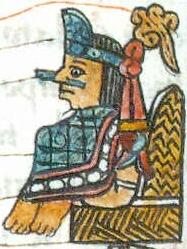
Cuitláhuac or Cuitláhuac was the 10th Huey Tlatoani (emperor) of the Aztec city of Tenochtitlan for 80 days during the year Two Flint (1520). He is credited with leading the resistance to the Spanish and Tlaxcalteca conquest of the Mexica Empire, following the death of his kinsman Moctezuma II.
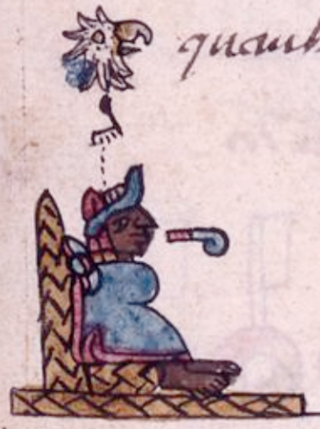
Cuauhtémoc, also known as Cuauhtemotzín, Guatimozín, or Guatémoc, was the Aztec ruler (tlatoani) of Tenochtitlan from 1520 to 1521, making him the last Aztec Emperor. The name Cuauhtemōc means "one who has descended like an eagle", and is commonly rendered in English as "Descending Eagle", as in the moment when an eagle folds its wings and plummets down to strike its prey. This is a name that implies aggressiveness and determination.
Montezuma or Moctezuma may refer to:

Moctezuma I, also known as Montezuma I, Moteuczomatzin Ilhuicamina or Huehuemoteuczoma, was the second Aztec emperor and fifth king of Tenochtitlan. During his reign, the Aztec Empire was consolidated, major expansion was undertaken, and Tenochtitlan started becoming the dominant partner of the Aztec Triple Alliance. Often mistaken for his popular descendant, Moctezuma II, Moctezuma I greatly contributed to the famed Aztec Empire that thrived until Spanish arrival, and he ruled over a period of peace from 1440 to 1453. Moctezuma brought social, economical, and political reform to strengthen Aztec rule, and Tenochtitlan benefited from relations with other cities.

Motecuhzoma Xocoyotzin, referred to retroactively in European sources as Moctezuma II, was the ninth Emperor of the Aztec Empire, reigning from 1502 or 1503 to 1520. Through his marriage with Queen Tlapalizquixochtzin of Ecatepec, one of his two wives, he was also king consort of that altepetl.

Tenochtitlan, also known as Mexico-Tenochtitlan, was a large Mexican altepetl in what is now the historic center of Mexico City. The exact date of the founding of the city is unclear, but the date 13 March 1325 was chosen in 1925 to celebrate the 600th anniversary of the city. The city was built on an island in what was then Lake Texcoco in the Valley of Mexico. The city was the capital of the expanding Aztec Empire in the 15th century until it was captured by the Tlaxcaltec and the Spanish in 1521.

Nezahualpilli was king (tlatoani) of the Mesoamerican city-state of Texcoco, elected by the city's nobility after the death of his father, Nezahualcoyotl, in 1472. Nezahuapilli's mother was Azcalxochitzin, who married Nezahualcoyotl after the death of her first husband, King Cuahcuauhtzin of Tepechpan.
Doña Isabel Moctezuma was a daughter of the Aztec ruler Moctezuma II. She was the consort of Atlixcatzin, a tlacateccatl, and of the Aztec emperors Cuitlahuac, and Cuauhtemoc and as such the last Aztec empress. After the Spanish conquest, Doña Isabel was recognized as Moctezuma's legitimate heir, and became one of the indigenous Mexicans granted an encomienda. Among the others were her half-sister Marina Moctezuma, and Juan Sánchez, an Indian governor in Oaxaca.

Cervecería Cuauhtémoc Moctezuma (Cervecería Cuauhtémoc Moctezuma / Heineken México) is a major brewery based in Monterrey, Nuevo León, Mexico, founded in 1890. It is a subsidiary of Heineken International.

The Pánuco River, also known as the Río de Canoas, is a river in Mexico fed by several tributaries including the Moctezuma River and emptying into the Gulf of Mexico. The river is approximately 510 kilometres (320 mi) long and passes through or borders the states of Mexico, Hidalgo, Querétaro, San Luis Potosí, Tamaulipas, and Veracruz. According to the Atlas of Mexico, it is the fourth-largest river in Mexico by volume of runoff, and forms the sixth-largest river basin in Mexico by area.
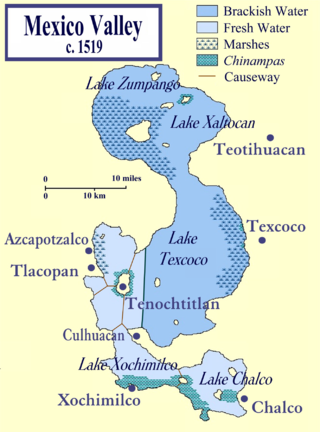
Tlacopan, also called Tacuba, was a Tepanec / Mexica altepetl on the western shore of Lake Texcoco. The site is today the neighborhood of Tacuba, in Mexico City.
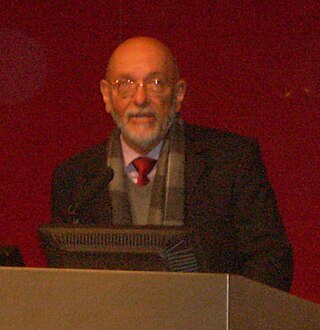
Eduardo Matos Moctezuma is a Mexican archaeologist. From 1978 to 1982 he directed excavations at the Templo Mayor, the remains of a major Aztec pyramid in central Mexico City.
Mayo is an Uto-Aztecan language. It is spoken by about 40,000 people, the Mexican Mayo or Yoreme Indians, who live in the South of the Mexican state of Sonora and in the North of the neighboring state of Sinaloa. Under the General Law of Linguistic Rights of the Indigenous Peoples" Law of Linguistic Rights, it is recognized as a "national language" along with 62 other indigenous languages and Spanish which all have the same validity in Mexico. The language is considered 'critically endangered' by UNESCO.
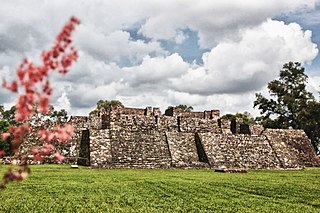
The Aztecs were a Pre-Columbian Mesoamerican people of central Mexico in the 14th, 15th, and 16th centuries. They called themselves Mēxihcah.

The Spanish conquest of the Aztec Empire was a pivotal event in the history of the Americas, marked by the collision of the Aztec Triple Alliance and the Spanish Empire, ultimately reshaping the course of human history. Taking place between 1519 and 1521, this event saw the Spanish conquistador Hernán Cortés, and his small army of soldiers and indigenous allies, overthrowing one of the most powerful empires in Mesoamerica.
Don Pedro (de) Moctezuma Tlacahuepan Yohualicahuaca was a son of the Aztec emperor Moctezuma II and María Miyahuaxochtzin, the daughter of Ixtlilcuecahuacatzin, ruler of Tollan.
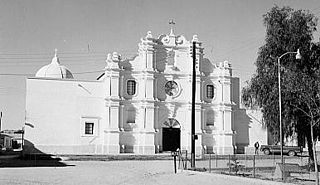
Moctezuma is a municipio (municipality) of the Mexican state of Sonora, located in the state's central region. It is also the name of its largest settlement and cabecera municipal.
Julio Rodolfo Moctezuma Cid was a Mexican lawyer who served as the first Secretary of Finance (1976–77) in the cabinet of President José López Portillo, as director-general of Pemex (1981–82) and as director-general of the now extinct Somex bank (1982–88).
Doña Isabel de Tolosa Cortés de Moctezuma, was a wealthy New Spanish heiress and the wife of conqueror and explorer Don Juan de Oñate who led an expedition in 1598 and founded the first Spanish settlement in what is now the state of New Mexico. She was the granddaughter of Spanish explorer and conquistador Hernán Cortés, and the great-granddaughter of Aztec Emperor Moctezuma II.

Xanthopastis regnatrix, the Spanish moth or convict caterpillar, is a moth of the family Noctuidae. It occurs in the United States, where it is found from North Carolina to Texas and south to Florida. Strays have been recorded as far north as coastal New York, and inland as far north as Kentucky.













